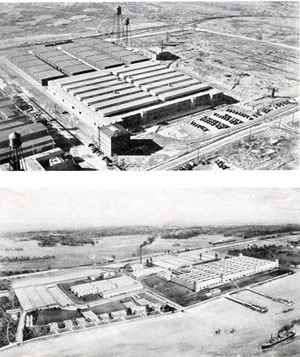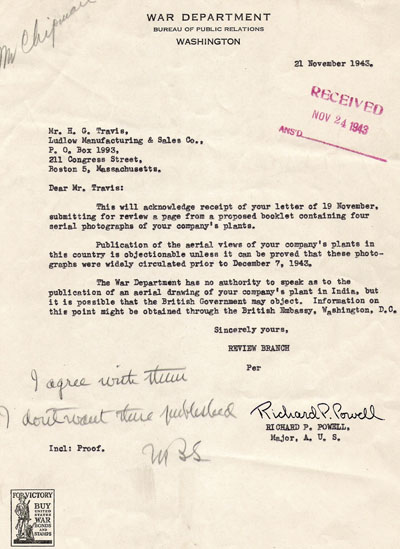Internal Affairs
By: Justin B., Zack Z., Jacob C.,
and Jeremy M.
In the early to mid 1940’s, the Ludlow Mills were supplying the armed forces with equipment. Since the mill workers were working so well, the vice president of the Ludlow Manufacturing Associates wanted to create pamphlets and hand them out in honor of their work and to show their importance in supplying the troops. This man’s name was H. G. Travis. He figured he should get permission to do this, so he sent a letter to Major Richard P. Powell, in the Pentagon on November 19, 1943.
(Notice the date on the letter)
What major world wide event was happening around this time?
H. G. Travis
asked for permission to hand out pamphlets for the mill workers. Inside,
the pictures showed mills in India, Delaware, Pennsylvania, and Ludlow. Travis
was asking permission because the booklet could possibly give information to
the enemy.
Three days later, on November 21, 1943, a response came back to Travis from the Pentagon with a statement. As an act of security, the statement was an objection to the publication of the pamphlet because if one of these pamphlets (which contained aerial photos of the mills) got into the wrong hands, so to say, another attack (like on Pearl Harbor) could occur.
In this response letter, Major Powell acknowledges the letter sent by Travis. Powell states that the publication of the photos of the U. S. companies is objectionable, unless the photos were widely circulated before 12/7/43 (the day the Japanese attacked Pearl Harbor). The War Department had no power over the two non-U.S. photos, and therefore refers Travis to their respective governments.

Pamphlet showing LMA production centers
|

Rejected LMA pamphlet
|
What does this pamphlet show?
Top Left: Edge Moor, Delaware; Top Right: Allentown, Pennsylvania; Bottom Left: India; Bottom Right: Ludlow Mills
These primary sources tell us much about the events that were occurring during the time of the Ludlow Manufacturing Associates. For one, we see how the L.M.A. was eager to show its citizens and workers their importance in World War II. We can also infer from this that there were multiple parts of the L.M.A. and that generals and majors in the armed forces were concerned with internal safety. As you can see, these 60 year old papers can provide a lot of information about the past.

